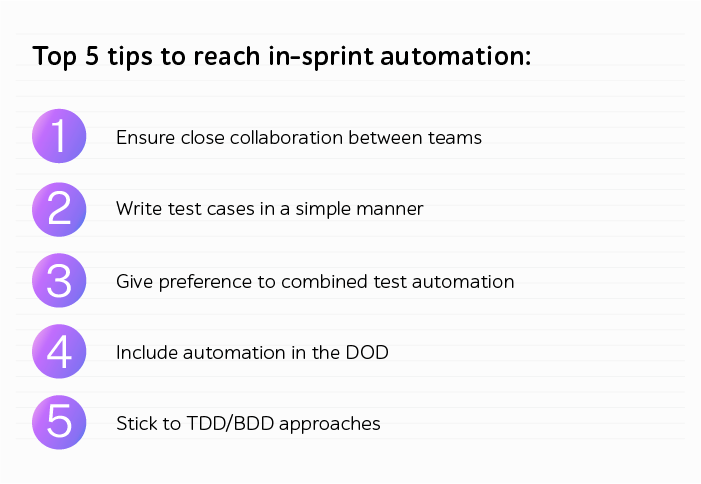
How to attain in-sprint test automation to reinforce development processes
Having become a buzzword in the global context, test automation today is an integral part of Agile and DevOps culture. McKinsey states that as of August 2020, 41% of representatives have successfully applied automation across their entire enterprise or fully automated processes within at least one function.
However, these efforts are no longer sufficient due to the boosted development pace and an increased difficulty to withstand the competition. Maintaining business as usual and keeping the risks of automation from blocking timely releases at bay, companies not only shift left but introduce in-sprint automation to improve process reliability and cut release cycles.
In the article, we’ve touched upon its value for a business, outlined the associated challenges of its introduction, and assembled hands-on tips to achieve it with ease.
In-sprint automation: what’s in it for your business?
We all know how time- and effort-consuming regression testing may be, sometimes leaving no room for implementing innovation to obtain a competitive edge.
Completing test automation within the limits of one sprint helps companies significantly fast-track these repetitive activities, maximize test coverage, detect issues earlier in the development life cycle, ease iterations, and obtain a clear overview of the product quality.
Embarking on an in-sprint automation journey allows businesses to test continuously at the speed of DevOps while providing enhanced collaboration opportunities between the core teams ― development, automation, and QA ― enabling them to follow the same pace.
Challenges associated with introducing in-sprint automation
The adoption of in-sprint automation has its specific problems:
- Short sprints provoking the lack of time to automate. In general, the QA team must fix spotted defects within a sprint that may last only two weeks. Which can be insufficient to perform automation, as it requires the collaboration of both automation engineers and developers.
- The choice of suitable tools or frameworks. The toolkit should enable the design and initial creation of tests (logic description, business logic, a stable part of the requirements/application) even without accessing the software UI, which is often subject to changes. Such an approach allows starting automation of API and unit tests without wasting time. Thus, the frameworks should support a myriad of tests, as well as flexibility and allowing any changes introduced by evolving business demands.
- The shortage of the necessary technical expertise. Automation is a tricky activity that calls for deep technical expertise from all the parties involved. Therefore, companies should engage solution architects and establish close interaction between them and engineering teams ensuring smooth design, configuration, and implementation of in-sprint automation.
Top 5 tips to seamlessly attain in-sprint automation
Only 1% of the World Quality Report’s 2020-2021 respondents stated that they confronted no challenges in applying automated testing in Agile. Getting things done in such a small period is only possible when applying a complex strategy.
Below, we’ve assembled the most essential QA tips to help companies achieve faster time to market and exceptional software quality through in-sprint test automation.

Tip 1 – Make the QA team closely collaborate with the business and the Dev team
In-sprint automation presupposes that it’s impossible to automate the entire scope. The choice of the relevant tests should be made after discussing and providing in-depth analysis with project stakeholders who give valuable data on how often would-be clients will use particular features.
Constant and early interaction with the Scrum development team is another vital aspect to streamline testing activities. For instance, by previously agreeing with the software engineers upon the identifiers of UI elements or API methods, the QA experts can start creating automated tests even before writing the code of a particular feature. Developers work carefully on the discussed functionality bearing in mind that they need to create it in a way that allows further automation.
Tip 2 – Write test cases in a simple but meaningful manner
Voluminous test cases with the overcomplicated flow may not be an option when it comes to automating within the same sprint. By checking only one part of functionality at a time using precise steps and clearly defined expected results, the QA engineers decrease the efforts required for their preparation and concentrate more on the automation itself.
Tip 3 – Apply combined test automation approach
Determining a mixture of layers for executing test scenarios considerably eases the testing process, reducing the risk of errors and hastening the speed of running verifications. By leveraging API, the QA engineers access the application UI quicker, which allows avoiding prerequisite steps in the automated scenario and scaling down the time for executing automated tests.
Tip 4 – Include automation in the definition of done (DOD)
By embracing automation as a full-fledged part of DOD, the entire Scrum team focuses on both its great significance and reflects on the emerging bottlenecks or techniques that went well to constantly work on process improvements and attain the desired objective.
Tip 5 – Stick to test-/behavior-driven development approaches (TDD/BDD)
The utilization of such practices enables high overall responsibility for quality within your Agile or DevOps teams. Writing unit (TDD) or acceptance and later unit (BDD) tests before the functional code with their automation following allows for shifting QA activities left, increasing test coverage, detecting issues earlier in the development process, and safe refactoring.
Closing remark
Proficiency takes time. Things that seem overly complicated at first, later become easy to perform. In-sprint automation is among them.
To attain this mission-critical objective, businesses may design a profound automation strategy focusing on close cooperation between the Dev and QA teams, writing simple but descriptive tests, automating wisely, advancing DOD, and adhering to TDD/BDD.
Altogether, these steps contribute to hastening release velocity, spotting issues earlier in the development cycle, and following a quality mindset to help organizations get the extra mile and obtain continuous improvement.
Reach out to a1qa’s experts to get professional help in attaining in-sprint automation.








